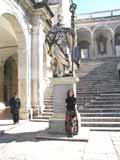
|
|
|
Encountering Cassino was a chance occurrence. Half way between Rome and Naples, we were sapped of energy from our day at the Lost City of Pompei so found solace from our driving by finding an exit to this wonderful city. Here we not only got some much needed rest but found one the most beautiful sights we had seen thus far. High atop the mountain right outside our bedroom window lay the grounds of the Monte Cassino Monastery. This Monastery was founded by St. Benedict about 529 A.D. on the remnants of a pre-existing Roman fortification of the “Municipum Casinum”. This was supposedly “heathen cult” which was still practicing on this mountain site in the temple of Apollo and in a nearby holy grove to which a sacrifice area was adjoining. Montecassino became famous for the extraordinary life and the grave site of its founder. Apparently a very well know abbey by Christians throughout the world - but – I had never heard of it. The place had endured a number of unfortunate disasters since. Around 577, the monastery was destroyed by the Longobards of Zotone, Duke of Beneventum, but early in the eighth century Pope Gregory II commissioned the Brescian Petronace to rebuild the monastery. In 883, the Saracens invaded and sacked the Monastery and burnt it down, causing the death of Bertarius its saint Abbot, Founder of medieval Cassino. The surviving monks first fled to Teano and later to Capua. Monastic life was only fully resumed towards the middle of the tenth century, thanks to Abbot Aligerno. The third destruction, caused by an earthquake, occurred in 1349. Nothing but a few walls remained of Abbot Desiderius' impressive building. Many new additions and embellishments were made during reconstruction so that the Abbey assumed a grandness and imposing appearance which it preserved until February 15, 1944. During the final stages of world war II, Montecassino just happened to be on the firing line. The abbey came to be the anchor of the German presence in this part of Italy and, after a battle that lasted almost six months, the Allies - a mixture of Poles, New Zealanders and Indian troops - eventually bombed it to ruins.
Reconstruction and decoration works took more than a decade and were exclusively financed by the Italian State. | ||
| Copyright © 2004 Douglas Hall |
| All Rights Reserved |

 This place of peace and shelter for hundreds of defenseless civilians, in only three hours was reduced to a heap of debris under which many of the refugees died. Amazingly, only a couple of things remained after the allied forced dropped 500 tons of bombs on the Abbey.
(It is amazing that anything remained) The statue of St. Benedict (left) and the cell of St. Benedict were the survivors.
This place of peace and shelter for hundreds of defenseless civilians, in only three hours was reduced to a heap of debris under which many of the refugees died. Amazingly, only a couple of things remained after the allied forced dropped 500 tons of bombs on the Abbey.
(It is amazing that anything remained) The statue of St. Benedict (left) and the cell of St. Benedict were the survivors.